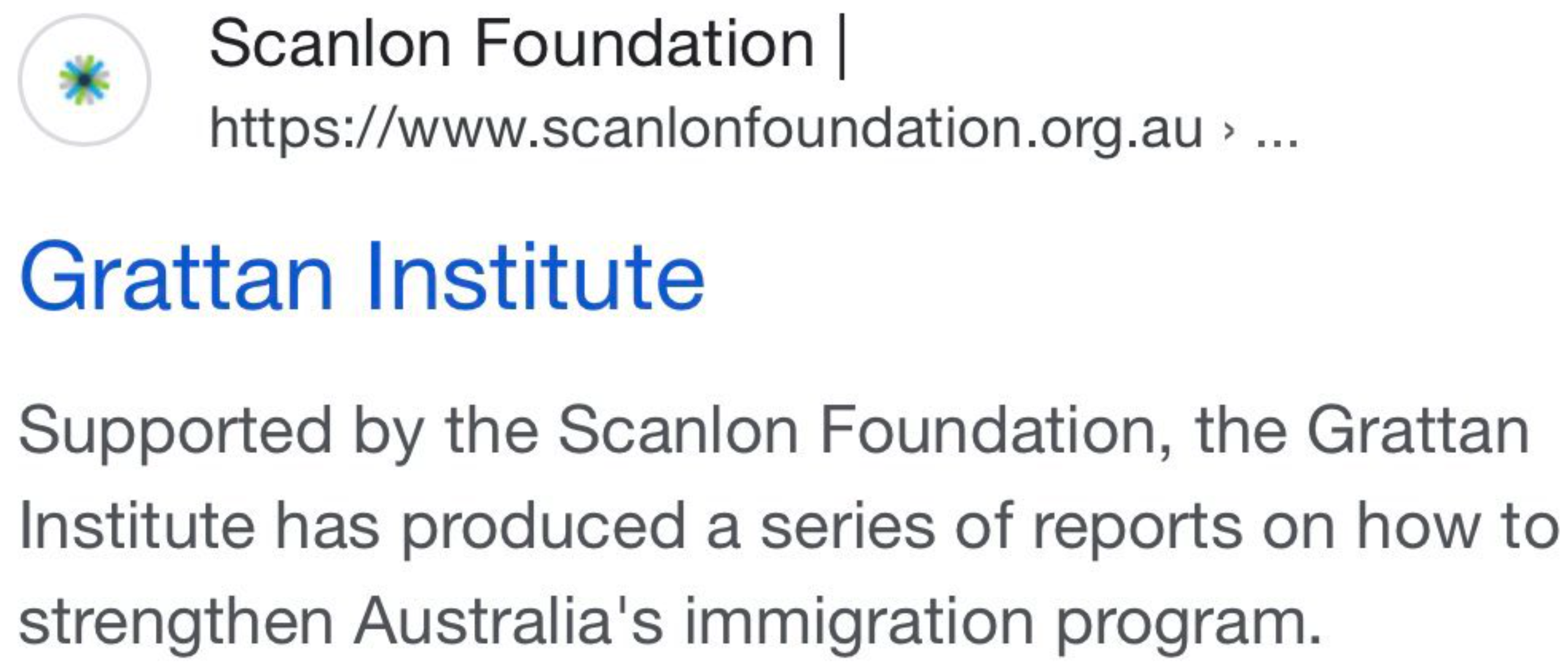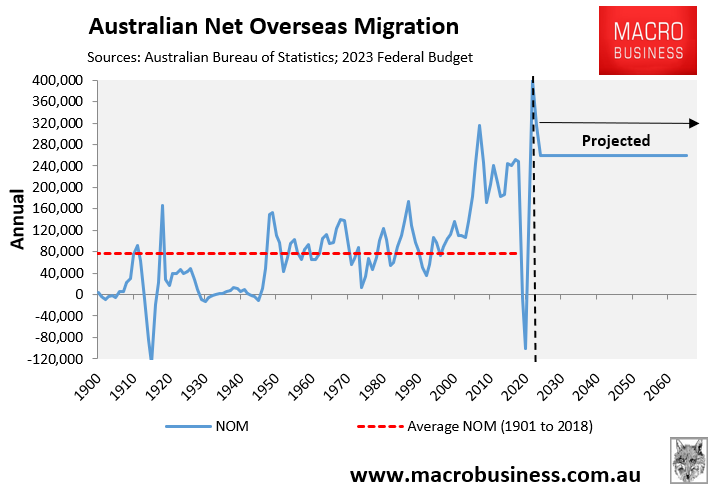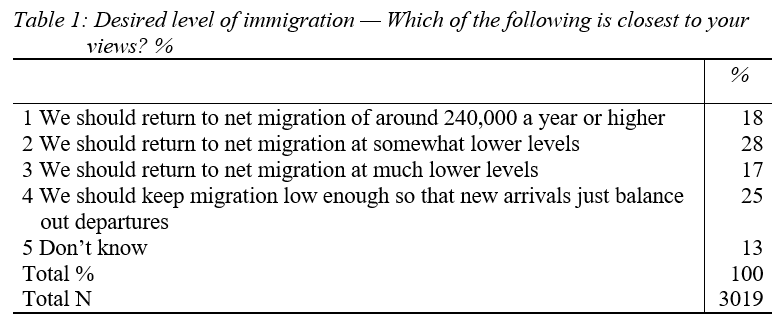The Grattan Institute should always be viewed with suspicion on immigration policy.
Why? Because its immigration “research” is sponsored by the pro-Big Australia Scanlon Foundation, which was established by real estate developer and rich lister Peter Scanlon:

As explained by the Herald-Sun’s John Masanauskas in 2009 (link no longer active):
MAJOR investor and former Elders executive Peter Scanlon hardly blinks when asked if his conspicuous support for a bigger population is also good for business.
Mr Scanlon, whose family wealth is estimated to be more than $600 million, has set up a foundation with the aim to create a larger and socially cohesive Australia.
It also happens that Mr Scanlon has extensive property development interests, which clearly benefit from immigration-fuelled high population growth.
“My primary driver in (setting up the foundation) is if we don’t have growth we are going to lose all our youth because the world is looking to train people around the world,” he explains.
“Instead of having stagnant growth, we’re going to have a serious decline.”
Mr Scanlon believes that governments aren’t doing enough to sell the benefits of a bigger population so he has put his money where his mouth is…
Presumably, this financial support from the Scanlon Foundation is why the Grattan Institute continuously spouts the virtues of a ‘strong’ migration program, while playing down the negative impacts.
A classic example of Grattan’s pro-immigration bias was on display this week when Program Director Brendan Coates published an article in The Australian entitled “Don’t blame migrants for the housing crisis”.
Coates’ central argument is that because Australia has less migrants than were forecast by the federal budget pre-pandemic, we cannot blame the extreme rebound in immigration for the housing crisis:
About a quarter of those 1.5 million migrants – 400,000 in the current financial year – are already here. And net overseas migration will fall to 315,000 next financial year, and then to 260,000 in the years after that.
Most of the increase in migrants simply reflects the reopening of Australia’s borders after Covid, rather than any government policy change.
Over the first two years of the pandemic, nearly 400,000 international students, working holiday-makers and temporary sponsored workers left Australia. In the past year, the number of these temporary visa-holders in Australia has rebounded to pre-pandemic levels.
The government’s decision to increase the annual permanent migrant intake from 160,000 a year before the pandemic to 195,000 for 2022-23, and down to 190,000 for 2023-24, has had little impact on migration numbers to date. That’s because most permanent visas are issued to migrants already here on temporary visas. But if the higher permanent intake is continued, it will add an extra 30,000 a year to net overseas migration in the long term as more temporary visa-holders stay in Australia…
Rather than a ‘‘Big Australia’’ policy, the contribution of migration to Australia’s population is expected to remain smaller than was expected before Covid for nearly a decade. This year’s budget predicts that by 2024 there will still be 215,000 fewer migrants in Australia than the Coalition government had expected in the 2019 budget.
Migration certainly means we need more homes. But how does a smaller population than was expected just four years ago lead to a rental crisis?
This is classic gaslighting by Coates: the insidious alteration of the markers of reality until we no longer know what is real.
It is egregious to suggest that Australia’s population growth needs to ‘catch up’ to some outrageous forecast after the slow-down during the pandemic.
This claim is based on the convoluted logic that current population levels are ‘lower than expected’ – these expectations having been set by the Australian Treasury’s extreme forecasts prior to the pandemic.
Coates implies that Australia’s population goal becomes whatever Treasury has defined it to be at some prior point.
Thus, any subsequent real-world deviation from Treasury’s ludicrous target pre-pandemic requires that Australia must ‘catch up’ – no matter the cost to ordinary Australians.
The fact remains that there is nothing normal about the latest immigration projections.
Australia is officially forecast to add a record 1.5 million net overseas migrants in only five years (i.e. 300,000 a year):

Source: 2023 federal budget
That’s way above the record average 220,000 net overseas migrants that landed annually in Australia in the 15 years leading up to the pandemic.

Because of this unprecedented net overseas migration (NOM), the Budget projects that Australia’s population will swell by 2.18 million in just five years:

Source: 2023 federal budget
That’s the equivalent of adding five Canberra’s or one Perth to the country’s current population – in only five years!
Australia did not build enough housing for the record numbers of migrants that landed in Australia in the 15 years leading up to the pandemic, as illustrated clearly in the next chart:

So, providing housing for an extra 2.18 million people in five years will obviously be an insurmountable task, especially when the entire housing construction industry is on its knees suffering from widespread insolvencies amid soaring materials prices and financing (interest rate) costs.
In turn, Australia’s housing (rental) crisis will continue to worsen, which will throw thousands of Australians into homelessness.
If the Albanese Government genuinely cared about ending the nation’s housing shortage, it would run an immigration program significantly lower than the growth of the overall dwelling stock, not the other way around.
Thus, it is time for outfits like the Grattan Institute to stop scapegoating a ‘lack of supply’ and to speak honestly and openly about the issue.
Australia will never build enough homes so long as its population continues to grow like a science experiment via extreme levels of immigration.
We didn’t build enough in the ‘Big Australia’ 15 years leading up to the pandemic. And we certainly won’t under Labor’s even larger immigration program.
Australia’s housing problem is really an excessive immigration problem.
Finally, the Grattan Institute should acknowledge that Australian voters overwhelming do not support high immigration:

Source: The Australian Population and Research Institute
Let’s not pretend that the Grattan Institute is impartial in the immigration debate. It is a stealth ‘Big Australia” lobbyist for the business sector.
Always follow the money.

